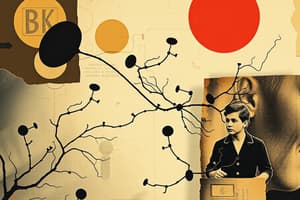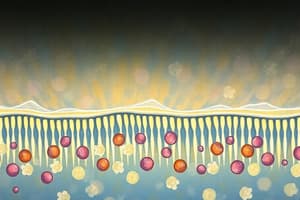Podcast
Questions and Answers
Facilitated diffusion requires __________________.
Facilitated diffusion requires __________________.
carrier proteins
Facilitated diffusion occurs ____.
Facilitated diffusion occurs ____.
- Out of the cell only
- In either direction depending on the temperature
- Into the cell only
- In either direction depending on the size of the molecule
- In either direction depending on the concentration gradient of the molecule (correct)
Facilitated diffusion is used to transport _____
Facilitated diffusion is used to transport _____
sugars
Osmosis is best defined as the movement of _____.
Osmosis is best defined as the movement of _____.
Which of the following will pass through a cell membrane most easily?
Which of the following will pass through a cell membrane most easily?
A red blood cell placed in a hypertonic solution will ________________.
A red blood cell placed in a hypertonic solution will ________________.
The sodium-potassium pump functions to pump _____.
The sodium-potassium pump functions to pump _____.
What is the source of energy used to power the sodium-potassium pump?
What is the source of energy used to power the sodium-potassium pump?
During one cycle, the sodium-potassium pump binds and moves _____.
During one cycle, the sodium-potassium pump binds and moves _____.
A ligand is _________________________.
A ligand is _________________________.
Cell products that are to be secreted are processed and packaged into vesicles by the:
Cell products that are to be secreted are processed and packaged into vesicles by the:
A solution consists of a ____________ which is dissolved by the ______________.
A solution consists of a ____________ which is dissolved by the ______________.
Large polar molecules, such as proteins are able to diffuse through the membrane easily.
Large polar molecules, such as proteins are able to diffuse through the membrane easily.
Which organelle uses oxygen during the process of cellular respiration?
Which organelle uses oxygen during the process of cellular respiration?
An atom with 11 neutrons, 11 protons, and 12 electrons would have a charge of
An atom with 11 neutrons, 11 protons, and 12 electrons would have a charge of
How many ATPs does one FADH2 yield when it goes into the ETS (electron transport system)?
How many ATPs does one FADH2 yield when it goes into the ETS (electron transport system)?
The osmolality of a red blood cell is __________________.
The osmolality of a red blood cell is __________________.
Red blood cells in an isotonic solution are _____.
Red blood cells in an isotonic solution are _____.
Red blood cells put in a hypertonic solution will _______________________
Red blood cells put in a hypertonic solution will _______________________
Red blood cells put in a hypotonic solution will _______________________
Red blood cells put in a hypotonic solution will _______________________
Flashcards are hidden until you start studying
Study Notes
Facilitated Diffusion
- Requires carrier proteins to transport substances across cell membranes.
- Occurs in either direction depending on the concentration gradient of the molecule, not restricted to one side.
Osmosis
- Defined as the movement of water molecules from an area of low solute concentration to an area of higher solute concentration.
- Osmolarity of red blood cells is approximately 300 mOsmoles.
Membrane Permeability
- Small nonpolar molecules pass through cell membranes more easily than small polar molecules.
- Large polar molecules, like proteins, cannot diffuse easily through the membrane.
Red Blood Cell Behavior
- A red blood cell placed in a hypertonic solution will shrink due to water loss.
- In isotonic solutions, red blood cells maintain a lozenge shape.
- In hypotonic solutions, red blood cells undergo hemolysis and may burst.
Sodium-Potassium Pump
- Functions to transport sodium ions out of the cell and potassium ions into the cell.
- Powered by the hydrolysis of ATP.
- During one cycle, it moves 3 Na+ ions out and 2 K+ ions into the cell.
Ligands
- A ligand is a small molecule that binds to a membrane-bound receptor, initiating a cellular response.
Cellular Structures
- Secretory products are processed and packaged into vesicles by the Golgi Complex.
- Mitochondria use oxygen for cellular respiration.
Solutions
- A solution consists of a solute, which is dissolved by a solvent.
Atomic Charge
- An atom with 11 neutrons, 11 protons, and 12 electrons has a charge of -1 due to the excess of electrons.
Energy Yield in Cellular Metabolism
- One FADH2 yields 2 ATP when it enters the electron transport system.
Studying That Suits You
Use AI to generate personalized quizzes and flashcards to suit your learning preferences.



